So how do you eat figs anyway? Figs are a popular fruit for eating dried, which makes their flavour more intense and the texture chewier. Like many other dried fruits, dried figs are also good for cooking with – especially for baking.
Eating dried figs whole is simple enough – you’ll want to discard the hard stalk (hold it, eat the rest of the fruit off it, and chuck the stalk away), and that’s about all there is to it.
How to eat fresh figs is a different question, but one to which there’s not a single correct answer. If there’s one rule to always follow, again, it’s to discard the stalk. With fresh figs, it’s very easy to just twist the stalk off before tucking into them whole.
The skins of fresh figs are perfectly edible, although not to everyone’s taste, so you may prefer to peel them first. It’s worth noting that early season figs have thin and delicate skins, whereas late season figs have thicker, less palatable ones. These thicker skins are easy to remove with a good quality vegetable peeler, while you might be better off peeling the thinner ones away with your fingers so as not to ruin the delicate fruit inside.
Unlike dried figs, the inside of fresh figs is soft and naturally jam-like. Other ways of getting to the centre while avoiding the skin include cutting your fig in half and eating the centre out with a spoon, or cutting them into wedges and eating them as you would an orange wedge.
Fresh figs pair particularly well with nuts and/or soft goat and sheep cheeses. You can also cook them to make them even more sweet and juicy. This can be particularly desirable with unripe figs. You can bake them whole or halve them and place them on a grill. Both methods will caramelise the figs slightly and make them equally good as a simple dessert topped with crushed nuts and honey or a topping of their own on goat cheese salads and even pizza.
Fig recipes













